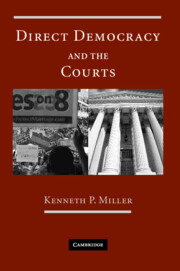Book contents
- Frontmatter
- Contents
- List of Tables and Figures
- Preface
- Introduction: A Clash of Rising Powers
- PART I THE QUEST FOR MAJORITY RULE
- PART II COUNTERING THE MAJORITY
- PART III THE MAJORITY STRIKES BACK
- Conclusion: A New Constitutional Equilibrium
- Appendix: Post-Election Initiative Invalidations
- References
- Index
- References
Introduction: A Clash of Rising Powers
Published online by Cambridge University Press: 05 June 2012
- Frontmatter
- Contents
- List of Tables and Figures
- Preface
- Introduction: A Clash of Rising Powers
- PART I THE QUEST FOR MAJORITY RULE
- PART II COUNTERING THE MAJORITY
- PART III THE MAJORITY STRIKES BACK
- Conclusion: A New Constitutional Equilibrium
- Appendix: Post-Election Initiative Invalidations
- References
- Index
- References
Summary
A century ago, the Progressive Era's enthusiasm for “experiments in government” led many states to embrace new forms of direct democracy. The experiments included recall of public officials, popular referendum over acts of the legislature, and, most consequentially, the citizen's initiative process. The initiative device allowed citizens to propose laws, place them on the ballot, and enact them at the polls by simple majority vote. For the first time, popular majorities could bypass their representatives and directly dictate policy – an innovation that challenged long-established principles of American constitutional design. But, radical though they were, the reforms did not abolish representative institutions nor create what James Madison would call a “pure democracy.” Instead, the initiative, referendum, and recall were grafted into state constitutions alongside the legislature, executive, and courts to create a new, hybrid constitutional system, part representative, part direct. With these experiments in place, it remained to be seen how they would work – how direct democracy and representative institutions would interact in different states, under various circumstances, and over time.
This book analyzes the relationship between two of these powers – the initiative process and the courts – over the past century. This relationship is compelling because the two forces are near opposites. Whereas the initiative process is designed to translate the majority's preferences into law, judicial review is designed in part to counter majorities.
- Type
- Chapter
- Information
- Direct Democracy and the Courts , pp. 1 - 16Publisher: Cambridge University PressPrint publication year: 2009



